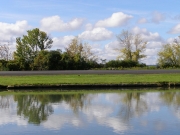Just Say NO ..... to Detention Ponds
Civil engineers design them, landscape architects loath them, developers wonder why we need them and municipal engineers often require them - I hate them. Retention and Detention ponds have become the standard for stormwater management on commercial and residential projects throughout most of the US. They were originally intended for flood control and were later incorporated into water quality requirements as well. They serve in their capacity to attenuate peak flows from new development reasonably well, but their usefulness stops there. Here are a few of the reasons that I'm not a fan of detention/retention ponds:

